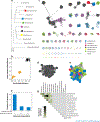Actinobacteriophages: Genomics, Dynamics, and Applications
- PMID: 32991269
- PMCID: PMC8010332
- DOI: 10.1146/annurev-virology-122019-070009
Actinobacteriophages: Genomics, Dynamics, and Applications
Abstract
Actinobacteriophages are viruses that infect bacterial hosts in the phylum Actinobacteria. More than 17,000 actinobacteriophages have been described and over 3,000 complete genome sequences reported, resulting from large-scale, high-impact, integrated research-education initiatives such as the Science Education Alliance Phage Hunters Advancing Genomics and Evolutionary Sciences (SEA-PHAGES) program. Their genomic diversity is enormous; actinobacteriophages comprise many architecturally mosaic genomes with distinct DNA sequences. Their genome diversity is driven by the highly dynamic interactions between phages and their hosts, and prophages can confer a variety of systems that defend against attack by genetically distinct phages; phages can neutralize these defense systems by coding for counter-defense proteins. These phages not only provide insights into diverse and dynamic phage populations but also have provided numerous tools for mycobacterial genetics. A case study using a three-phage cocktail to treat a patient with a drug-resistant Mycobacterium abscessus suggests that phages may have considerable potential for the therapeutic treatment of mycobacterial infections.
Keywords: bacteriophage; genomics; mycobacterium; phage therapy.
Figures







References
Publication types
MeSH terms
Grants and funding
LinkOut - more resources
Full Text Sources
Other Literature Sources

